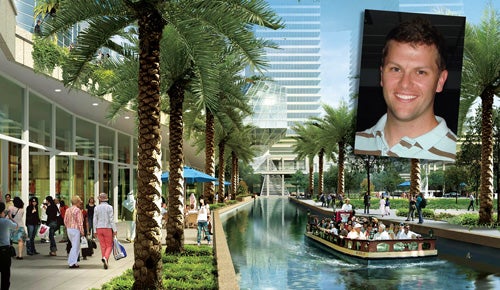Our Man In Abu Dhabi

Nick Healey ’03 is “our man in Abu Dhabi” in the United Arab Emirates.
 For the last two years, the landscape architecture graduate has been part of a four-person design team working in a part of the world noted for its progressive architecture and innovative development.
For the last two years, the landscape architecture graduate has been part of a four-person design team working in a part of the world noted for its progressive architecture and innovative development.
He is heavily involved in two major projects. Both are managed by his employer, Boston’s Carol R. Johnson Associates, Inc, which also employs seven other URI alumni.
The Shams Abu Dhabi Central Park and Public Landscapes project, a mixed-use development off the main island of Abu Dhabi, will ultimately house 55,000. Shams Island is about the size of downtown Boston, and its central park is about the size of Boston Public Gardens.
The Johnson firm was also awarded the design for the entire public realm of the island, including four kilometers of canal and adjacent amenities, coastal walks, and streetscape design.
“We won the project largely because of the introduction of passive cooling techniques where cold seawater is pumped through heat exchangers to release cooled air onto the outdoor walkways and plazas in the park. While the country enjoys moderate temperatures a few months of the year, it can hit 120°F in the summer,” explained Healey.
The smaller project, Marasy Harbor, is a residential waterfront development, located on two plots in one of the oldest, most culturally sensitive areas of Abu Dhabi. The area, originally a boatyard, will maintain a nautical concept.
Before he was sent to the UAE, Healy worked on the Boston Chinatown project developing design and construction documents, the Ridge Road Project in Rochester, N.Y., doing a visual impact assessment for the artery that links the city with its suburbs, and a highway interchange project in Chicago.
As a student, he played a design role in the building of Hope Commons and the University’s three newest residence halls. He also assisted the team that prepared a feasibility study for the LEED designation for our Center for Biotechnology and Life Sciences (see accompanying story).
“Abu Dhabi is doing its best to implement sustainability standards, similar to the LEED program in the U.S., to reduce its current carbon footprint, which remains one of the highest in the world,” said Healy.
Healy enjoys his work. “The boundaries are being pushed at all times, which seems to be the reason Abu Dhabi and Dubai are on the world stage of development,” he said.
Still he misses his family back home. He’s able to visit a few times each year. “My phone bills have certainly been interesting,” he added.
By Rudi Hempe ‘62
 Home
Home Browse
Browse Close
Close Events
Events Maps
Maps Email
Email Brightspace
Brightspace eCampus
eCampus


